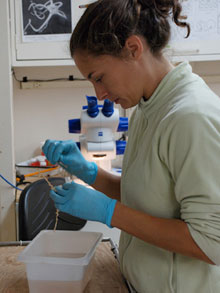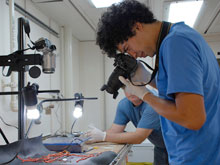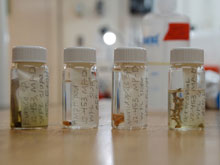Seeing It First Hand!
August 23, 2009
Santiago Herrera
Graduate Student
Massachusetts Institute of Technology – Woods Hole Oceanographic Institution
After more than 21 hours of time on the bottom, the remotely operated vehicle Jason II, from the Woods Hole Oceanographic Institution, has returned to the surface carrying dozens of samples collected from the seafloor. Aboard the NOAA oceanographic research vessel Ronald H. Brown crew members work with the Jason group to carry out the recovery; it requires precision and coordination to bring the almost 4,000 kilograms (8,818 pounds) of vehicle and its load back on deck safe and sound. Once everything has been safely secured onboard, our team of about 25 anxious scientists, armed with buckets of cold seawater, proceeds to scoop out the contents of Jason's receptacles.

Andrea Quattrini takes a tissue sample of a bamboo coral for genetic analysis. Click image for larger view and image credit.
We spent the next seven or eight hours after the recovery in a frenzy of photographing, describing, documenting, identifying, preserving, and cataloging every single bit of living or non-living specimen retrieved from the depths. During this first dive, Jason's robotic manipulator arms collected dozens of species of deep-sea animals, representing a diversity of taxonomic groups. Among the most common were soft and hard corals, shrimps, squat lobsters, sand hoppers, barnacles, brittle stars, and worms. Many of these creatures are so rare and unique that they need to be sent to expert taxonomists in different parts of the world to be accurately identified to the species level. It is still not unusual to find new species in each deep-sea exploration. We accompany most of the identifications of these organisms with molecular analyses of their DNA. Such analyses allow us, among other things, to distinguish genetic differences among species and populations and to infer the evolutionary history that gave rise to these differences. This is the main area of research that I study.
I have spent the majority of my time since 2007 dedicated to my career as a researcher in the laboratory, investigating the biology of animals that thrive in the depths of the ocean. My most recent project was conducted at the Universidad de los Andes in Bogotá, Colombia, and the National Museum of Natural History of the Smithsonian Institution. It involved gene sequencing and “micro-skeleton” analyses from the tissues of specimens of deep sea bubblegum octocorals, like the one shown in the ![]() attached video. These specimens came from collections at various museums throughout the world.
attached video. These specimens came from collections at various museums throughout the world.
By looking at the genetic material stored in the cells of these amazing creatures, I have learned lots of interesting things about their life in this very cold and dark world. However, it was not until now, after observing the palpitating coral communities through the eyes of Jason and holding some of these living animals in my hands, that I have begun to understand many of the things that I have seen behind my bench and under the microscope. It is certainly an extraordinary opportunity to experience these remote, but vivid and colorful ecosystems firsthand. I cannot wait until Jason comes back from the next dive with a new load!





























